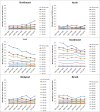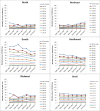Inequalities in esophageal cancer mortality in Brazil: Temporal trends and projections
- PMID: 29554098
- PMCID: PMC5858754
- DOI: 10.1371/journal.pone.0193135
Inequalities in esophageal cancer mortality in Brazil: Temporal trends and projections
Abstract
The main objective of the study was to analyze the effect of age, period and birth cohort on esophageal cancer mortality in Brazil and its geographic regions, per sex. An ecological study is presented herein, which evaluated the deaths by esophageal cancer and the distribution, per geographic region. Poisson Regression was utilized to calculate the effects of age, period and birth cohort, and projections were made with the statistical software R, using the age-period-cohort model. Projection of data covered the period 2015-2029. Regarding the geographic regions of Brazil, a decrease was verified, throughout time, for the mortality rates of the South and Southeast regions, for men and women. For the North, Northeast and Midwest regions, an increase was evidenced in mortality rates, mainly for men, after the 2000's. Regarding the projections, a progressive increase of mortality rates was verified for the Northeast and North regions. Divergences evidenced for observed and projected esophageal cancer mortality rates revealed inequalities among the geographic regions of Brazil.
Conflict of interest statement
Figures





Similar articles
-
Trends and predictions for gastric cancer mortality in Brazil.World J Gastroenterol. 2016 Jul 28;22(28):6527-38. doi: 10.3748/wjg.v22.i28.6527. World J Gastroenterol. 2016. PMID: 27605887 Free PMC article.
-
PANCREATIC CANCER IN BRAZIL: MORTALITY TRENDS AND PROJECTIONS UNTIL 2029.Arq Gastroenterol. 2018 Jul-Sep;55(3):230-236. doi: 10.1590/S0004-2803.201800000-59. Arq Gastroenterol. 2018. PMID: 30540083
-
Melanoma mortality in Brazil: trends and projections (1998-2032).Cien Saude Colet. 2019 Apr;24(4):1551-1561. doi: 10.1590/1413-81232018244.13932017. Epub 2019 May 2. Cien Saude Colet. 2019. PMID: 31066856
-
[Non-communicable chronic diseases in Brazil: from risk factors to social impact].Bol Oficina Sanit Panam. 1996 May;120(5):389-413. Bol Oficina Sanit Panam. 1996. PMID: 8924219 Review. Portuguese.
-
Epidemiology of esophageal cancer in 2020 and projections to 2030 and 2040.Thorac Cancer. 2023 Jan;14(1):3-11. doi: 10.1111/1759-7714.14745. Epub 2022 Dec 8. Thorac Cancer. 2023. PMID: 36482832 Free PMC article. Review.
Cited by
-
Association of Esophageal Cancer Mortality with Municipal Socioeconomic Deprivation Level in Japan, 2013-2017: An Ecological Study Using Nationwide Data.Int J Environ Res Public Health. 2022 Apr 30;19(9):5483. doi: 10.3390/ijerph19095483. Int J Environ Res Public Health. 2022. PMID: 35564875 Free PMC article.
-
Treatment of esophageal cancer: surgical outcomes of 335 cases operated in a single center.Rev Col Bras Cir. 2021 Feb 15;48:e20202723. doi: 10.1590/0100-6991e-20202723. eCollection 2021. Rev Col Bras Cir. 2021. PMID: 33605392 Free PMC article.
-
Analysis of the effects of the age-period-birth cohort on cervical cancer mortality in the Brazilian Northeast.PLoS One. 2020 Feb 19;15(2):e0226258. doi: 10.1371/journal.pone.0226258. eCollection 2020. PLoS One. 2020. PMID: 32074101 Free PMC article.
-
Comparison of Secular Trends in Esophageal Cancer Mortality in China and Japan during 1990-2019: An Age-Period-Cohort Analysis.Int J Environ Res Public Health. 2022 Aug 18;19(16):10302. doi: 10.3390/ijerph191610302. Int J Environ Res Public Health. 2022. PMID: 36011937 Free PMC article.
References
-
- Ferlay J, Soerjomataram I, Ervik M, Dikshit R, Eser S, Mathers C, et al. GLOBOCAN 2012 v1.0, Cancer incidence and mortality worldwide: IARC Cancer Base No. 11 International Agency for Research on Cancer; 2014. Available from: http://globocan.iarc.fr.
-
- Thuler FP, Forones NM, Ferrari AP. Advanced esophageal cancer: still a delayed diagnosis. Arq Gastroenterol. 2006; 43(3):206–11. - PubMed
-
- American Cancer Society. Global cancer facts & figures 2008 [Internet]. 2nd ed. Atalanta: American Cancer Society; 2011. Available from: http://www.cancer.org/acs/groups/content/@epidemiologysurveilance/docume....
-
- Thrift AP, Whiteman DC. The incidence of esophageal adenocarcinoma continues to rise: analysis of period and birth cohort effects on recent trends. Annals of Oncology 23: 3155–3162, 2012. doi: 10.1093/annonc/mds181 - DOI - PubMed
-
- Barrios E, Sierra MS, Musseti C, Forman D. The burden of oesophageal cancer in Central and South America. Cancer Epidemiology 44S (2016) S53–S61. - PubMed
MeSH terms
LinkOut - more resources
Full Text Sources
Other Literature Sources
Medical

